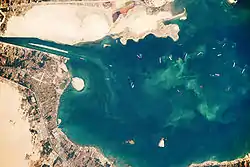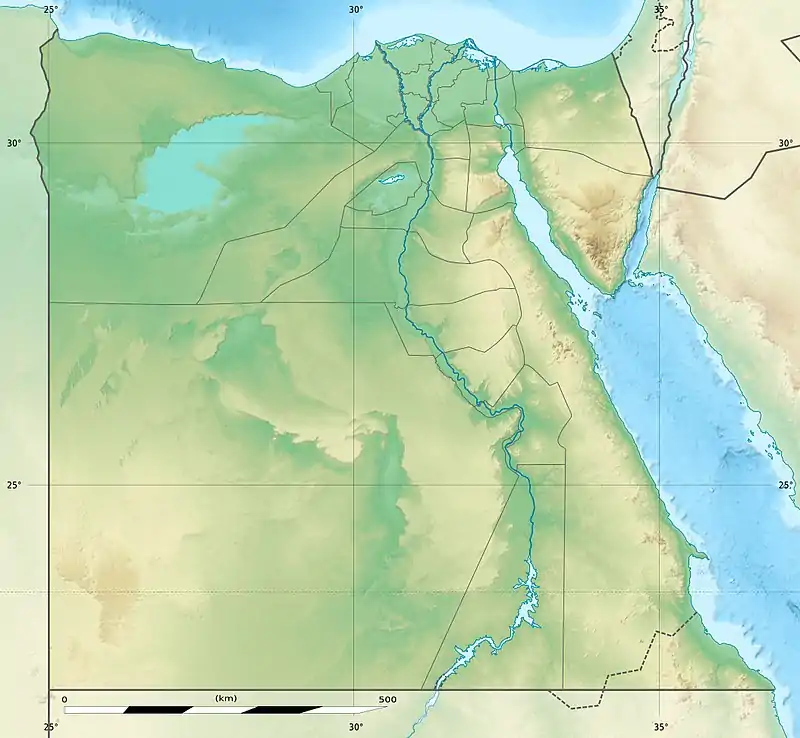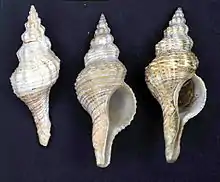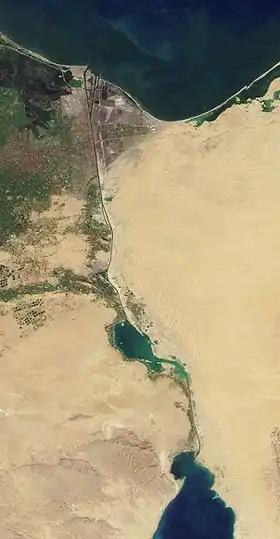Great Bitter Lake
The Great Bitter Lake (Arabic: البحيرة المرة الكبرى; transliterated: al-Buhayrah al-Murra al-Kubra) is a saltwater lake in Egypt, connected to the Mediterranean Sea and the Red Sea via the Suez Canal. It is connected to the Small Bitter Lake (Arabic: البحيرة المرة الصغرى; transliterated: al-Buhayrah al-Murra as-Sughra), through which the canal also runs. Before the canal was built (1869), the site was a dry salt valley or basin.[1][2] References are made to the Great Bitter Lake in the ancient Pyramid Texts.[3] Ships traveling through the Suez Canal use the Great Bitter Lake as a "passing lane", where they can change their position in line or turn around.[1]
| Great Bitter Lake | |
|---|---|
 | |
 Great Bitter Lake | |
| Coordinates | 30°20′N 32°23′E |
| Lake type | salt lake |
| Primary inflows | Suez Canal |
| Primary outflows | Suez Canal |
| Basin countries | Egypt |
| Surface elevation | 0 m (0 ft) |
Salinity
When the Suez Canal was closed for eight years, beginning during the Six-Day War in 1967, the salinity of the lake increased substantially. The salinity of the lake depends on how much seawater flows into it from the Red and the Mediterranean seas.[4] Even when the canal is open, the Great Bitter Lake has a salinity level "more than twice" the level of the sea. While this makes it difficult for plant life to exist there, many species (of crabs, for example) migrate from the Red Sea through the area.[5]
As the canal has no locks, sea water flows freely into the lake from the Mediterranean and the Red Sea. In general, north of the lakes the current reverses seasonally, being north-going in winter and south-going in summer.[6] South of the lakes, the current is tidal, reversing with the tides in the Red Sea.[7] Fish can migrate, generally in a northerly direction, through the canal and lakes in what is known as a Lessepsian migration. This means that some Red Sea species have come to colonize the eastern Mediterranean.[2][5]
Molluscan Species
Description and Brief History
Following the opening of the Suez Canal in 1869, connecting the Red Sea to the Mediterranean Sea, the area has witnessed massive marine migrations from the Canal to the Mediterranean. Anti-Lessepsian migrations, species migrating from the Mediterranean Sea to the Red Sea, were rare.[8] The first recorded molluscan anti-Lessepsian migrant was Cerastoderma glaucum by Fisher (1870).
It was found that the hypersaline state of the water in the lake makes it almost impossible for fauna and flora to grow there. Nevertheless, some sea weed was found on the eastern side of the lake, giving a slight hope of prolific biotope.[8]
In 1998, Hoenselaar and Dekker analyzed and studied the material collected in 1950 by Beets (1953) in which they discovered a total of 44 gastropods and 47 bivalve species inside the lake. Among these species, it was noticed that only 3 gastropods and 5 bivalves were of Mediterranean origin. The rest were all originally from the Red Sea. This imbalance of origin is due to the water currents which are mainly directed towards the Mediterranean Sea, making it harder for species in general to migrate from the Mediterranean Sea towards the Red Sea.[8] Nevertheless, in a time-lapse of over 50 years since 1950, it is likely that more molluscan populations be detected.
Gastropods and Bivalves of the Great Bitter Lake
In the below tables, 31 gastropods (table 1) and 19 bivalves (table 2) are listed and described individually based on the study of Hoffmen, Dekker, and van Heugten (2006).[8] The gastropods Pusulina radiata and Cyclope neritea, and the bivalves Cerastoderma glauca and Tapes decussatus are the only anti-Lessepsian species that are originally from the Mediterranean Sea.
| Family | Genus | Species | Author | Location & Origin |
| Nacallidea | Cellana | rota | (Gmelin, 1791) | Abu Sultan, Red Sea |
| Fissurellidae | Diodora | funiculata | (Reeve, 1850) | Abu Sultan |
| Trochidae | Trochus | erithreus | Brocchi, 1821 | Abu Sultan, Red Sea |
| Clanculus | pharaonius | (Linnaeus, 1758) | Abu Sultan, Red Sea | |
| Pagodatrochus | variabilis | (H.Adams, 1873) | Abu Sultan, Red Sea | |
| Ethminolia | hemprichi | (Issel, 1869) | Abu Sultan, Red Sea | |
| Pseudominolia | nedyma | Melvill, 189n | Abu Sultan, Red Sea | |
| Cerithiidae | Cerithium | scabridum | Philippi, 1848 | Abu Sultan, Red Sea |
| Dialidae | Diala | varia | Adams A., 1861 | Abu Sultan, Red Sea |
| Lithipidae | Stylifernia | goniochila | Adams A., 1860 | Abu Sultan, Red Sea |
| Gibborisoa | virgata | (Philippi, 1849) | Abu Sultan, Red Sea | |
| Obtortionidae | Finella | pupoides | Adams A., 1860 | Abu Sultan, Red Sea |
| Planaxidae | Planaxis | griseus | (Brocchii, 1821) | Abu Sultan, Red Sea |
| Potamididae | Potamides | conicus | (de Blainville, 1829) | Abu Sultan, Red Sea & Mediterranean |
| Rissoidae | Pusillina | radiata | (Philippi, 1836) | Abu Sultan, Mediterranean |
| Strombidae | Tricornis | tricornis | (Lightfoot, 1786) | Abu Sultan, Red Sea |
| Muricidae | Murex | forskoehlii | Roding, 1798 | Al Fayed, Red Sea |
| Chicoreus | virgineus | (Roding, 1789) | Al Fayed, Red Sea | |
| Fasciolariidae | Fusinus | verrucosus | (Gmelin, 1791) | Abu Sultan, Red Sea |
| Nassarius | erythraeus | (Issel, 1869) | Abu Sultan, Red Sea | |
| Nassariidae | Cyclope | neritea | (Linnaeus, 1758) | Abu Sultan, Mediterranean |
| Olvidae | Ancilla | lineolata | (Adams A., 1853) | Abu Sultan, Red Sea |
| Pyramidellidae | Tiberia | fasciata | (Jickeli, 1882) | Abu Sultan, Red Sea |
| Chrysallida | maiae | (Hornung & Mermod, 1924) | Abu Sultan, Red Sea | |
| Syrnola | arabica | (Issel, 1869) | Abu Sultan, Red Sea | |
| Turbonilla | Abu Sultan, Red Sea | |||
| Bullidae | Bulla | ampulla | Linnaeus, 1758 | Abu Sultan, Red Sea |
| Haminoeidae | Diniatys | dentiferus | (Adams A., 1850) | Abu Sultan, Red Sea |
| Liloa | curta | (Adams A., 1850) | Abu Sultan, Red Sea | |
| Siphonariidae | Siphonaria | crenata | de Blainville, 1827 | Abu Sultan, Red Sea |
| Ellobiidae | Laemodonta | monilifera | (H. & A. Adams, 1854) | Abu Sultan, Red Sea |
| Family | Genus | Species | Author | Location & Origin |
| Noetiidae | Striarca | erytrae | (Issel, 1869) | Abu Sultan, Red Sea |
| Mytilidae | Brachidontes | pharaonic | (Fischer P., 1870) | Abu Sultan, Red Sea |
| Musculista | senhousia | (Benson in Cantor, 1842) | Abu Sultan, Red Sea | |
| Lucinidae | Pillucina | angela | (Melvill, 1899) | Abu Sultan, Red Sea |
| Pillucia | vietnamica | Zorina, 1970 | Abu Sultan, Red Sea | |
| Cardiolucina | semperiana | (Issel, 1869) | Abu Sultan, Red Sea | |
| Ungulinidae | Diplodonta | subrotunda | (Issel, 1869) | Abu Sultan, Red Sea |
| Chamidae | Chama | asperella | Lamarck, 1819 | Abu Sultan, Red Sea |
| Cardiidae | Cerastoderma | glaucum | (Poiret, 1789) | Abu Sultan, Mediterranean |
| Fulvia | fragilis | (Forskal, 1775) | Abu Sultan, Red Sea | |
| Tellinidae | Psammotreta | turgida | (Deshayes, 1854) | Abu Sultan, Red Sea |
| Tellina | Abu Sultan, Red Sea | |||
| Psammobiidae | Soletellina | ruppeliana | (Reeve, 1857) | Abu Sultan, Red Sea |
| Petricolidae | Choristodon | hemprichii | (Issel, 1869) | Abu Sultan, Red Sea |
| Laternulidae | Laternula | subrostrata | (Lamarck, 1818) | Abu Sultan, Red Sea |
| Veneridae | Timoclea | roemeriana | (Issel, 1869) | Abu Sultan, Red Sea |
| Gafrarium | pectinatum | (Linnaeus, 1758) | Abu Sultan, Red Sea | |
| Callista | florida | (Lamarck, 1818) | Abu Sultan, Red Sea | |
| Tapes | decussatus | (Linnaeus, 1758) | Abu Sultan, Meditarranean |
.jpeg.webp)
Additional notes on some molluscan species
- D. funiculata. Originally found alive between Saudi Arabia and western India.[8] It is 8 mm tall and belongs to the family of keyhole limpets. After it’s death it transforms into a sediment.[9]
- D. varia. Originally known as Diala semistriata[8].Its first record in the Mediterranen was in Isarel in 1984. It is 3 to 4 mm tall, has a spiral shape and is translucent, with colors that vary from white to black with some patterns all over.[10]
- G. virgata. Known as Alaba virgata. It was later proven that its genus must be changed to Gibborisoa.[8]
- P. conicus. Member of the horn snail family.[11] Located alive in both the Red and the Mediterranean Seas prior to the opening of the Suez Canal.[8] It was argued that its presence here and there was due to it being transported by birds.
- N. erythraeus. Member of the family of nassa mud snails.[12] It is also known as Nassarius pauper from the Indo-West-Pacific. Its name was changed to N. erythraeus after it was found in the Red Sea because of its species which was different.[8]

Between spring 2016 and winter 2017, a study by Dar et al. (2020) detected the presence of 41 different species of 4 phylas among which 12 molluscan species. Out of all phylas, molluscs recorded the highest density with a record of 90,632 individuals per m2. This is due to the dominant presence of Modiolus oriculatus (75,052 individuals per m2 annually).[13]
Molluscs and Heavy Metals
The Great Bitter Lake’s bottom soil is mainly composed of mud and sand (mostly carbonate)[8] which can be related to the extensive and continuous drilling activities happening in the Suez Canal for its expansion.[13] The soil is bleak due to the stagnant nature of the lake combined with the accumulation of pollutants coming from the naval traffic that occurs inside the lake. However, the motionless state of the lake transforms the lake sediments into a depository of heavy metals.[14] There are several factors that determine the availability of heavy metals at the bottom of the lake among. In the recent years, a major part of heavy metal pollution has been originating from the following: overpopulation, industrialization, sewage, dumpsites, crude oil spills, agricultural chemicals, and more.[14] Once these heavy metals integrate with the sediments composing the lake’s soil, they serve as a guide to local pollution, answering the questions of where, how, and when did the polluting event occur. Heavy metals are spread out heterogeneously over the lake’s area. A study has shown the different concentrations of these metals in 11 areas of the lake: 6 were onshore at 2 to 3 meters deep, and 5 were offshore at a depth of 12–15 meters.[13]
Results by Dar et al., (2020):[13]
The below results interpret the lowest and highest concentrations of each heavy metal found in the Great Bitter Lake at shallow and deep water as well as in the sediments.
Station 1: in water, the lowest rates of copper (Cu), zinc (Zn) and iron (Fe) were found there (6.09, 4.25, and 11.08 micrograms per liter, or ug/L). The highest rate of cadmium (Cd) (0.10 ug/L) was also found at this station. In sediment, the lowest value of lead (Pb) was recorded there (4.67 ug/g).
Station 2: in water, Cd reached its lowest value here (0.01 ug/L). In sediment, Zn reached its highest level in this station (258.51 ug/g).
Station 3: in water, the lowest rate of manganese (Mn) was found here (0.12 ug/L). In sediment, Pb (40.65 ug/g) and (nickel) Ni (66.63 ug/g) recorded their highest scores here.
Station 4: in water, the peak densities of Cu (9.59 ug/L) and Fe (116.41 ug/L). In sediment, it showed the lowest results of Cu (14.37 ug/g), Mn (17.3 ug/g), Cd (1.18 ug/g), Zn (19.13 ug/g), Fe (1317.61 ug/g), and Ni (2.11 ug/g).
Station 6: in water, recorded the highest values of Mn (3.23 ug/L). In sediment, the highest score for Cd (9.37 ug/g).
Station 7: in water, the maximum concentration of Zn was found here (11.19 ug/L).
Station 9: in sediment, Mn (394.217 ug/L) and Fe (227.96 ug/L) recorded their highest values at this station as well as their maximum concentrations (Mn, 394.23 ug/g and Fe 2274.96 ug/g)
Station 10: in water, recorded the highest value of Pb (4.35 ug/L) and in sediment, the highest concentration of Cu (84.36 ug/g).
The above results demonstrate a widespread distribution of heavy metals all over the lake at different depths in both water and sediments. Each station records a certain level for the heavy metals available in its periphery. We can see that each type of chemical reaches its highest (or lowest) concentration somewhere in the lake and each at different spots. On one side, the distribution shows that the pollution is not only concentrated in one area of the lake but that it is vastly spread out, and on the other side, it shows that molluscan species inside the lake are not all exposed to the same quantity nor type of heavy metals. Consequently, molluscan species will accumulate different types of heavy metals depending on their location in the lake, which will be used to estimate the various toxicity rates in the water of the lake.
Molluscs as Biomonitors
While sediments are a great means of accumulating heavy metals in an aquatic body, molluscs complete the study of heavy metals in their ecosystem by spotting the pollution rate in a particular area in the environment. When studying pollution levels in the sea, molluscs are more sensitive to it,[15] thus, relying on these organisms could be an optimal technique to detect pollution and toxicity levels.
Molluscs are the best bioindicator of heavy metal pollution in an aquatic body due to their ability to absorb heavy metals. These heavy metals will be stored in their soft tissue as well as their shells. The danger and toxicity of these chemical elements varies according to the amount absorbed by the shells and the species absorbing it. Thus, in order to protect aquatic macro-fauna, it is necessary to refrain from exceeding the limit at which the heavy metals become toxic.[14] Exceeding the threshold might lead to shell deformations and imposex, a disease that causes females to develop male reproductive organs.[14]
Although traces of those heavy metals are found in both the soft tissues and the hard shells, the latter provide a more precise indication of the pollution in the area it was found.[14] This is so thanks to a strong composition of the shell compared to that of the tissue, which ascertains the conservation of these metals inside it. Also, shells act as a historical tracker, maintaining the information recorded intact, even after the organisms’ deaths.
So, despite the fact that it is more common for metals to be collected by the soft tissues of organisms, the hard shells are better preservers of heavy metals and the information hidden behind their presence in the Great Bitter Lake, in space and time.[14]
Molluscs and Infectious Diseases
Viral disease - Molluscan species are strong organisms that can handle chemical contamination. Nevertheless, they are exposed to infectious diseases and pollution from human activities. The interaction of these two components have certain effects on molluscs.[16] Many studies and experiments have been undertaken in this field to understand the physical and physiological behavior of molluscs. It was found that when certain species are exposed to a viral infection followed by an exposure to heavy metals such as those mentioned previously, their mortality rate increased. Also, if the roles were flipped and the species were first exposed to the heavy metals before exposure to the virus, their mortality rate increased even more.[16]
Respiratory disease - As previously mentioned, heavy metals can be harmless until a certain threshold is surpassed, especially in almost stagnant water bodies, where they accumulate and stay. However, once those levels are exceeded, they can negatively impact molluscs’ respiratory systems.[17] In many cases, one of the effects of exposure of molluscs to high levels of heavy metals is a reduction in oxygen, which can also be due to other factors such as an interrupted ventilation or a problem with gas transport between tissues.
Bacterial disease – Bacteria affects mulluscan species differently depending on their life stage.[16] Studies have been conducted to analyze the relationship between bacteria exposure and pollutants, in order to understand its effects on molluscs’ immunity. The results showed that when molluscs are only exposed to heavy metals, the contamination degree is less severe than them being exposed to both the heavy metals and the bacteria, and thus, their immune functions are more affected in the latter.[16] It was also discovered that their mortality rate increased in parallel to the drop in immunity.
Variations of Metals in Molluscs
Here we discuss and describe how different molluscs absorb different types of heavy metals at different rates. Heavy metals are not corrosive and thus subsist in the environment once released. Here are examples of these metals: Pb, Fe, mercury (Hg), Cd, arsenic (As), Cu, chromium (Cr), etc. Among the molluscan species in the Great Bitter Lake, M. auriculatus registered the highest rate of Fe whereas the Fusinus specie showed a higher rate of Ni in their shells compared to the Ni found in the sediments. In addition to that, Cardium papyraceum shells recorded the highest absorption level of Pb in the lake. I was observed that Brachidontes pharaonic and C. papyraceum have a tendency of mineralizing Cd in their shells.[14]
As a result of studying each mollusc’s behavior towards heavy metals, it was found that Ni was the chemical that incorporates in shells the most easily.[14] It was also discovered that the incorporation and mineralization of heavy metals within molluscs’ shells depended on several factors: growth rate and cessation, metabolism, and environmental conditions.[14] For this reason, each species selects metals according to their needs and not to the bioavailability in the ecosystem.
The Role of the Biology of Molluscs in Heavy Metal Accumulation
The biology of molluscan species defines their ability and capacity to store heavy metals. Factors that play a role in determining the levels of heavy metals within molluscs’ shells are:[14] sex, size, diet, spawning, tissue composition, reproductive cycle.
Quincy Agreement
On 14 February 1945, in the last year of World War II, Great Bitter Lake was the site of the Quincy Agreement. U.S. President Franklin D. Roosevelt, having flown directly from the Yalta Conference with Winston Churchill and Joseph Stalin, met on board the naval cruiser USS Quincy with Saudi Arabia's King Abdulaziz.[18]
President Roosevelt's interpreter was U.S. Marine Corps Colonel Bill Eddy, who recorded the men's conversation in his book FDR Meets Ibn Saud. The meeting is the subject of a BBC documentary by Adam Curtis, entitled Bitter Lake (2015).[19]
Yellow Fleet
During the Six-Day War in 1967, the canal was closed. Egypt kept it closed until 1975, trapping 15 ships in the lake. These ships became known as the "Yellow Fleet", because of the desert sands which soon covered their decks.[20][21][22] The crews of the ships would eventually organize, share resources, and later set up their own post office and stamp. Two German-flagged ships eventually sailed out of the canal on their own power. Stranded cargo included various perishables (such as eggs and fruit), T-shirts, and a load of toys destined for Woolworth's.[23]
References
- "Great Bitter Lake, Egypt (Oct. 26, 2009)". Earth Observatory NASA. Archived from the original on 19 November 2016. Retrieved 18 November 2016.
- Madl, Pierre (1999). Essay about the phenomenon of Lessepsian Migration Archived 2016-07-31 at the Wayback Machine, Colloquial Meeting of Marine Biology I, Salzburg, April 1999 (revised in Nov. 2001).
- Jones, Greg (Apr 28, 2014). Waters of Death and Creation: Images of Water in the Egyptian Pyramid Texts. BookBaby. ISBN 9781483526362. Retrieved 18 November 2016.
- El Baz, Farouk (January 1, 1984). The Geology of Egypt: An Annotated Bibliography. Brill Archive. p. 516. ISBN 9789004070196. Retrieved 18 November 2016.
- Elton, Charles S. (June 15, 2000). The Ecology of Invasions by Animals and Plants. University of Chicago Press. p. 96. ISBN 9780226206387. Retrieved 18 November 2016.
- Sears, M.; Merriman, D. (December 6, 2012). Oceanography: The Past. Springer Science & Business Media. p. 301. ISBN 9781461380900. Retrieved 18 November 2016.
- The Red Sea Pilot. Imray Laurie Norie & Wilson. 1995. p. 266.
- Hoffmen, Leon; Dekker, Henk (2006). "Marine Mollusca collected during a journey to the Great Bitter Lake (Suez Canal) and Nile Delta". Gloria Mairs. 45 (1–2): 30–45.
- "Diodora funiculata (Reeve 1850) - Encyclopedia of Life". eol.org. Retrieved 2020-11-25.
- "Diala varia". www.ciesm.org. Retrieved 2020-11-25.
- "Pirenella conica (Blainville 1829) - Encyclopedia of Life". eol.org. Retrieved 2020-11-25.
- "Reticunassa erythraea (Issel 1869) - Encyclopedia of Life". eol.org. Retrieved 2020-11-25.
- Belal, Aisha Ahmad M.; Dar, Mahmoud A. (2020). "Distribution and biodiversity of macro-benthic fauna in relation to some heavy metals at the Great Bitter Lakes, Suez Canal, Egypt". The Egyptian Journal of Aquatic Research. 46 (1): 49–56. doi:10.1016/j.ejar.2020.02.005.
- Dar, Mahmoud A.; Belal, Aisha A.; Madkour, Amany G. (December 2018). "The differential abilities of some molluscs to accumulate heavy metals within their shells in the Timsah and the Great Bitter lakes, Suez Canal, Egypt". The Egyptian Journal of Aquatic Research. 44 (4): 291–298. doi:10.1016/j.ejar.2018.11.008. ISSN 1687-4285.
- Hamed, Mohamed A.; Emara, Ahmed M. (2006). "Marine molluscs as biomonitors for heavy metal levels in the Gulf of Suez, Red Sea". Journal of Marine Systems. 60 (3–4): 220–234. Bibcode:2006JMS....60..220H. doi:10.1016/j.jmarsys.2005.09.007.
- Morley, N.J. (2010-01-21). "Interactive effects of infectious diseases and pollution in aquatic molluscs". Aquatic Toxicology. 96 (1): 27–36. doi:10.1016/j.aquatox.2009.09.017. ISSN 0166-445X. PMID 19850361.
- Spicer, John I.; Weber, Roy E. (1991-01-02) [1991]. "Respiratory impairment in crustaceans and molluscs due to exposure to heavy metals". Comparative Pharmacology and Toxicology. 100 (3): 339–342. doi:10.1016/0742-8413(91)90005-e. PMID 1687526.
- "President Roosevelt and King Abdulaziz". SUSRIS. 17 March 2005. Archived from the original on 11 November 2014. Retrieved 2014-11-10.
- MacInnes, Paul (January 24, 2015). "Adam Curtis: 'I try to make the complexity and chaos intelligible'". The Guardian. Archived from the original on 22 October 2016. Retrieved 18 November 2016.
- Blair, Jonathon (June 1975). "New Life for the Troubled Suez Canal". National Geographic. Archived from the original on April 20, 2012. Retrieved August 23, 2011.
- Pearson, John; Anderson, Ken (May 1975). "A 'new' Suez Canal shapes up for 1980s". Popular Mechanics. Hearst Magazines. 143 (5). Archived from the original on July 6, 2014. Retrieved August 23, 2011.
- Ian Russel. "Melampus in Suez (the tale of a soldier on the MS Melampus)". The Blue Funnel Line 1866 - 1986. Archived from the original on 2010-11-13. Retrieved 2011-04-30.
- Gregor, Karen. "The Yellow Fleet". BBC Radio. Archived from the original on 30 November 2016. Retrieved 18 November 2016.
External links
 Media related to Great Bitter Lake at Wikimedia Commons
Media related to Great Bitter Lake at Wikimedia Commons
